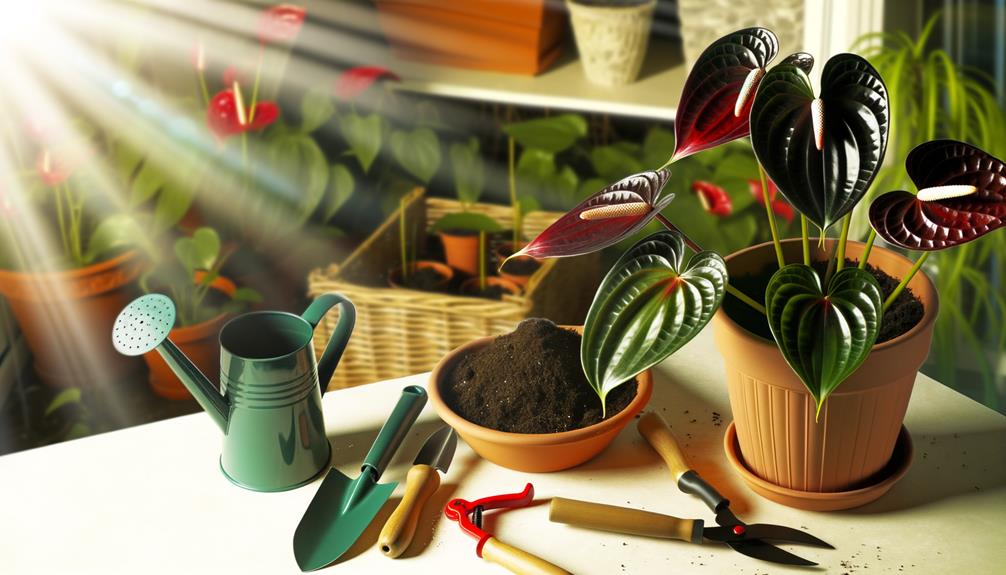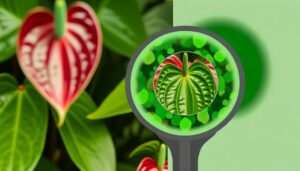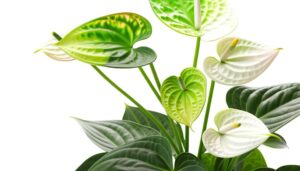How to Grow Anthurium Black Karma – A Complete Guide
To grow Anthurium Black Karma, select a terracotta pot with exceptional drainage. Use a soil mix including orchid bark, perlite, and peat moss, enriched with compost or worm castings, and add charcoal for freshness.
Place the plant in bright, indirect light, and water to keep the soil moist without being waterlogged. Maintain temperatures between 65-80°F and humidity above 60%, using a humidifier if needed.
Prune dead flowers and check regularly for pests and diseases. Propagate via root division or stem cuttings, adjusting care seasonally for best growth.
Continue for more in-depth insights and practical tips.

Key Takeaways
- Use a terracotta pot with excellent drainage and a well-draining soil mix of orchid bark, perlite, and peat moss.
- Place in bright, indirect light and avoid direct sunlight; consider using sheer curtains or artificial grow lights.
- Water consistently to keep soil moist but not waterlogged, adjusting frequency based on seasons.
- Maintain temperature between 65-80°F and humidity above 60%; use a humidifier if necessary.
- Regularly prune spent flowers at the base and check for pests and diseases to encourage new blooms.
Choosing the Right Pot
Selecting the appropriate container for your Anthurium Black Karma is crucial, as it directly affects the plant's root well-being and overall development. Choose a container that provides exceptional drainage to prevent root decay. Seek containers with numerous drainage openings at the base.
A container that's excessively large can retain surplus moisture, while a container that's too small can hinder root expansion. Terracotta containers are an excellent option because they're porous, enabling superior air circulation. Confirm the container has sufficient depth to accommodate the root system without overcrowding.
When transplanting, delicately loosen the roots to promote natural growth patterns. Monitor for indications of excessive or insufficient watering, adjusting your container selection accordingly for prime plant health.
Ideal Soil Mix
To create the ideal soil mix for Anthurium Black Karma, you'll need to focus on essential soil components that promote proper drainage and aeration.
Incorporate nutrient-rich additives like compost or worm castings to support healthy growth. This combination will provide a balanced environment, preventing root rot and promoting vibrant foliage.
Essential Soil Components
A well-balanced soil mix for Anthurium Black Karma should include a combination of orchid bark, perlite, and peat moss to guarantee proper aeration and drainage.
Orchid bark serves as the foundation, providing robust support while allowing roots to breathe.
Perlite, with its lightweight and porous nature, enhances drainage and prevents soil compaction.
Peat moss retains essential moisture without becoming waterlogged, ensuring a stable environment for your Anthurium's roots.
Mix these components in equal parts to create an ideal growing medium. This blend replicates the plant's natural habitat, promoting healthy growth.
Drainage and Aeration
Guaranteeing proper drainage and aeration in your soil mix is crucial for preventing root rot and promoting robust growth in Anthurium Black Karma.
You'll want a well-draining mix, so combine equal parts orchid bark, perlite, and peat moss. Orchid bark guarantees airflow around roots, while perlite adds lightness and prevents compaction. Peat moss retains moisture without becoming waterlogged.
You can also add a small amount of charcoal to absorb impurities and maintain soil freshness. When potting, make sure the container has drainage holes to allow excess water to escape.
Regularly check soil moisture; let the top inch dry out before watering again. This tailored approach will keep your Anthurium thriving with the perfect balance of moisture and air.
Nutrient-Rich Additives
Beyond drainage and aeration, integrating nutrient-rich additives into your soil mix provides the essential minerals and organic matter needed for Anthurium Black Karma to flourish.
Incorporate coconut coir for moisture retention and pine bark for structure. Add perlite to enhance aeration and charcoal to filter impurities.
Blend in worm castings, a natural fertilizer rich in nutrients, to support robust growth. Supplement with a slow-release, balanced fertilizer to ensure a steady nutrient supply.
Mixing in peat moss helps maintain the right pH and moisture levels. These components create a well-balanced, nutrient-dense environment, encouraging healthy roots and vibrant leaves.
Best Lighting Conditions
For best growth, place your Anthurium Black Karma in a location where it receives bright, indirect light, as direct sunlight can scorch its leaves. This plant thrives in conditions mimicking its native tropical habitat, so ensuring the right light balance is essential.
Here are some ideal light scenarios:
- Filtered sunlight through sheer curtains: This diffuses the sunlight, preventing leaf burn while allowing adequate light penetration.
- Positioning near east or north-facing windows: These orientations provide gentle morning or consistent indirect light without harsh afternoon rays.
- Artificial grow lights: When natural light isn't available, full-spectrum LED grow lights can supplement, ensuring consistent light levels year-round.
Watering Schedule
Maintaining an ideal watering schedule for your Anthurium Black Karma involves striking a balance between keeping the soil consistently moist and avoiding waterlogging, which can lead to root rot. You'll want to water your plant thoroughly, allowing the water to drain completely through the pot's drainage holes.
Check the soil's moisture level by inserting your finger about an inch deep; water only when the top inch feels dry. In warmer months, you may need to water more frequently, while in cooler months, reduce the frequency. Always use room-temperature water to prevent shocking the roots.
Temperature and Humidity
Maintaining your Anthurium Black Karma thrives involves maintaining a consistent temperature between 65-80°F and keeping humidity levels above 60%. These tropical beauties require a stable environment, so avoid placing them near drafts or heat sources.
High humidity can be achieved with a humidifier or by placing a water tray nearby. Mist the leaves regularly to replicate their natural habitat. Use a hygrometer to monitor humidity levels accurately. Group your plants together to create a humid microclimate.
Pay close attention to these conditions, as fluctuations can stress the plant and hinder its growth. By providing a warm and humid environment, you guarantee your Anthurium Black Karma displays its stunning foliage and vibrant blooms to their fullest potential.
Fertilizing Tips
To maximize your Anthurium Black Karma thrives, you need to focus on achieving a peak nutrient balance. Use a balanced, water-soluble fertilizer every six to eight weeks during the growing season.
Be mindful of the application timing, as over-fertilizing can lead to nutrient burn and hamper the plant's growth.
Optimal Nutrient Balance
Achieving a nutrient balance for your Anthurium Black Karma involves using a balanced, water-soluble fertilizer with a ratio like 20-20-20, applied every four to six weeks during the growing season. This guarantees your plant receives the essential macro-nutrients it needs for robust growth and vibrant blooms. To maximize effectiveness, dilute the fertilizer to half strength and apply it directly to the soil.
- Lush, glossy leaves: A sign that your plant is receiving the right nutrients.
- Vivid red spathes: Enhanced coloration due to balanced feeding.
- Healthy root system: Promotes strong foundation and nutrient uptake.
Using a precise nutrient mix helps your Anthurium thrive, making each feed a personal act of care and attention to detail.
Application Timing
Correctly timing fertilizer applications guarantees your Anthurium Black Karma receives nutrients exactly when it needs them for best growth and blooming.
Begin in early spring when new growth appears. Use a balanced, water-soluble fertilizer diluted to half strength. Apply every four to six weeks during the growing season, which spans spring through summer. Avoid fertilizing in the fall and winter when the plant's growth naturally slows. Over-fertilizing can lead to nutrient burn, so less is more.
Verify the soil is moist before application to prevent root damage. Monitor your plant closely; yellowing leaves can indicate over-fertilization, while slow growth may signal under-fertilization.
Tailoring your approach to your plant's needs guarantees vibrant blooms and lush foliage.
Pruning and Maintenance
Regular pruning and maintenance of your Anthurium Black Karma are essential for ensuring its best growth and vibrant appearance. Start by using clean, sharp scissors to trim any yellowing or dead leaves. This not only keeps the plant looking fresh but also prevents the spread of disease.
Inspect the plant weekly: Look for any damaged or wilted leaves that need removal.
Remove spent flowers: Cut these off at the base to encourage new blooms and maintain aesthetic appeal.
Check for root-bound conditions: If roots are circling the pot, it's time to repot into a larger container.
Keep your Anthurium thriving by maintaining a regular pruning schedule. This intimate care routine will reward you with a lush, healthy plant.
Common Pests and Diseases
How can you effectively identify and manage the common pests and diseases that threaten your Anthurium Black Karma?
Start by regularly inspecting your plant for pests like aphids, spider mites, and mealybugs. Look for signs such as discolored leaves, webbing, or a sticky residue. Use insecticidal soap or neem oil to address infestations promptly.
For diseases, root rot is a common issue caused by overwatering. Make sure your soil has excellent drainage and avoid waterlogged conditions. Fungal infections appear as leaf spots; treat them with a fungicide and remove affected foliage.
Propagation Methods
Mastering the propagation of Anthurium Black Karma involves using techniques such as division, stem cuttings, and seed germination to guarantee successful growth and reproduction.
Start with division by gently separating the plant's root clumps, making sure each section has healthy roots and leaves.
For stem cuttings, snip a healthy stem below a node and place it in water or a moist medium until roots develop.
Finally, seed germination requires patience; collect ripe seeds, clean them, and plant in a sterile, moist substrate.
- Division: Carefully separate root clumps with intact roots and leaves.
- Stem Cuttings: Clip a healthy stem below a node and root in water or moist substrate.
- Seed Germination: Clean and plant ripe seeds in a sterile, moist substrate.
These methods ensure your Anthurium Black Karma thrives.
Seasonal Care Adjustments
After mastering propagation techniques, you'll need to adjust your care regimen seasonally to guarantee Anthurium Black Karma remains healthy and vibrant year-round. Knowing how to tweak light, water, and humidity levels is essential. Here's a seasonal care guide:
| Season | Light | Watering |
|---|---|---|
| Spring | Bright, indirect light | Increase frequency, keep soil moist |
| Summer | Filtered light, avoid direct sun | Water regularly, ensure high humidity |
| Fall | Medium, indirect light | Gradually reduce, allow soil to dry slightly |
| Winter | Bright, indirect light | Water sparingly, avoid overwatering |
Conclusion
By following these guidelines, you'll guarantee your Anthurium Black Karma thrives.
Choose the right pot, use an ideal soil mix, provide excellent lighting, and maintain a consistent watering schedule.
Keep an eye on temperature and humidity, prune as needed, and stay vigilant against pests and diseases.
Propagate carefully and adjust care with the seasons.
With your attentive care, your Anthurium Black Karma will flourish, becoming a stunning centerpiece in your indoor garden.






